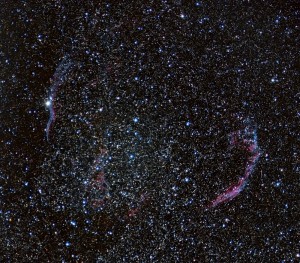Dave and I headed out to Grimes county Saturday night for some practice. I wanted to try and image the entire Veil, so I took the 70-200mm lens again. Setting up went fairly smooth, but I had some issues with focus. I could never get below a FWHM of about 5 in the focus tool and I’m not sure if it was me, the wider view, the lens and associated focus ring, or what… but I went with the best I could manage. My stars always seem bloated or fuzzy and again, I don’t know if it’s me or my set-up. I did notice in processing that I clearly need to learn the toolset better in PixInsight (deconvolution, morphological transformation, TGVDenoise, ANCDR, ATrousWaveletTransform, etc). It felt great to have a nice and clear night out and to get some practice under my belt.
“The Veil Nebula is a cloud of heated and ionized gas and dust in the constellation Cygnus. It constitutes the visible portions of the Cygnus Loop, a large but relatively faint supernova remnant. The distance to the nebula is not precisely known, but Far Ultraviolet Spectroscopic Explorer (FUSE) data supports a distance of about 1,470 light-years. In modern usage, the names Veil Nebula, Cirrus Nebula, and Filamentary Nebula generally refer to all the visible structure of the remnant, or even to the entire loop itself. The structure is so large that several NGC numbers were assigned to various arcs of the nebula. There are three main visual components:
– The Western Veil (also known as Caldwell 34), consisting of NGC 6960 (the “Witch’s Broom”, “Finger of God”, or “Filamentary Nebula”) near the foreground star 52 Cygni;
– The Eastern Veil (also known as Caldwell 33), whose brightest area is NGC 6992, trailing off farther south into NGC 6995 and IC 1340; and
– Pickering’s Triangle (or Pickering’s Triangular Wisp), brightest at the north central edge of the loop, but visible in photographs continuing toward the central area of the loop. NGC 6974 and NGC 6979 are luminous knots in a fainter patch of nebulosity on the northern rim between NGC 6992 and Pickering’s Triangle.
The nebula was discovered on 1784 September 5 by William Herschel.”

